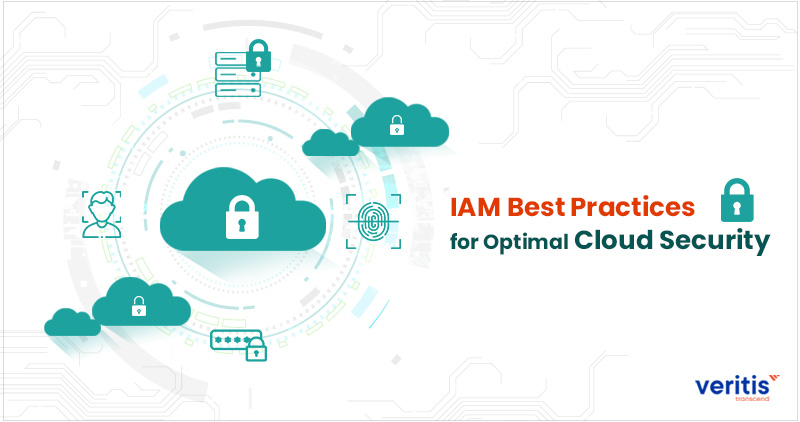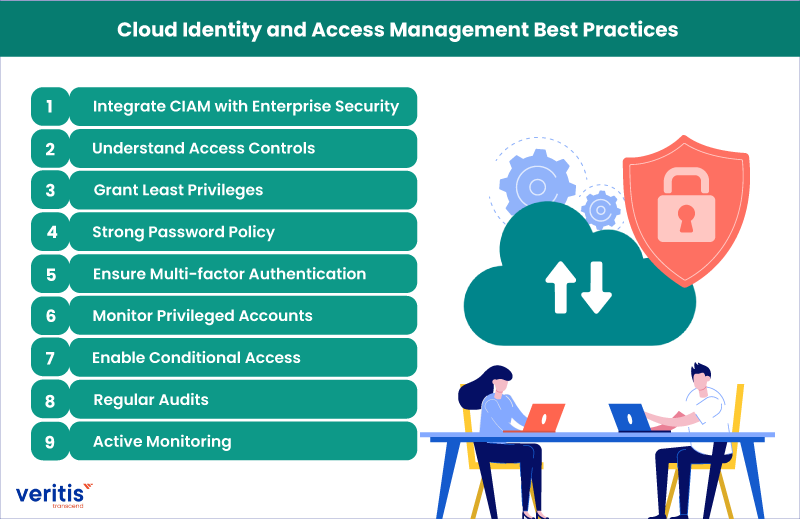
In recent years, most organizations have intensified their efforts to leverage the cloud. But many firms emphasize one lingering hesitancy: security.
Organizations may stray from their cloud journey when the cloud security enigma is combined with the complexities of hybrid or multi-cloud IAM solutions. Fortunately, modern identity and access management (IAM) solutions have emerged as the panacea to the cloud security conundrum. The correct IAM solution can help organizations navigate the cloud securely.
A sound IAM strategy is crucial in securing cloud assets against malicious access. Organizations can identify, authenticate, and authorize users with the proper IAM approach and provide user-specific access to cloud resources, services, and applications. Leading practices are still emerging around the use of cloud IAM.
Talk to Our Cloud Security Expert
How to Secure Cloud Assets with IAM
Cloud assets, from VMs and databases to storage buckets and APIs, demand robust security, particularly in shared, dynamic environments. The IAM framework stands as a crucial pillar, ensuring access is managed and monitored with utmost effectiveness.
Key approaches include:
1) Identify and classify cloud assets
Build a clear inventory of all cloud resources and group them by function, sensitivity, or environment (e.g., development, production).
2) Define roles and responsibilities
Map users and applications to IAM roles that align with their access requirements, a practice that instills confidence by ensuring tight alignment with the Principle of Least Privilege.
3) Use centralized identity sources
Leverage cloud IAM services, such as IAM in AWS, Azure Active Directory, or GCP IAM, or integrate with existing enterprise identity directories like LDAP or Active Directory for consistent policy enforcement.
4) Implement fine-grained access controls
Leverage role-based access control (RBAC) or attribute-based access control (ABAC) to tailor permissions precisely, rather than granting broad rights.
5) Enforce modern authentication and authorization
Incorporate strong authentication mechanisms (e.g., MFA) and dynamic authorization (such as conditional access policies) based on factors like time, location, and device trust.
6) Continuous monitoring and auditing
Track access logs, key usage, anomalies, or misconfigurations. This ensures the quick detection of unauthorized activity, supports regulatory compliance, and helps identify potential security threats before they escalate.
Let’s dwell on some of the notable IAM best practices:
Cloud IAM Best Practices
Here are the 9 IAM best practices for Cloud Identity and Access Management to enhance security and streamline management:

1) Integrate CIAM with Enterprise Security
Many organizations still rely on ‘security silos’ that leverage different strategies and technologies. However, this reliance can be counterproductive over time. Instead, organizations must hammer out an integrated security model. A crucial part of this transformation is CIAM integration with cloud security, which enables seamless unification of customer identity and access management with broader enterprise protection strategies. So, without further ado, integrate the cloud-based identity management solutions with enterprise security.
2) Understand Access Controls
Access management for cloud assets is vital. Organizations must understand who has cloud access, the level of access, and all possible tasks that can be performed with that access. Leverage AI and ML technologies to gain valuable insights into the processes that control access across your cloud environment. Use these insights to monitor your cloud and restrict malicious access and entitlement creep.
3) Grant Least Privileges
When forging the cloud IAM strategy, follow the ‘principle of least privilege access’ to grant only the necessary permissions to perform the task. Scope out what level of access users need to perform their duty, and hammer IAM policies that enable them to perform only those tasks. It is wise to establish a minimum access permission level initially and grant additional permissions as needed. Starting with permissions that are too lenient can be risky, and later adjusting them can be challenging.
4) Strong Password Policy
Implement a robust password policy that obligates users to create strong passwords and update them regularly. The policy must define password requirements, including the minimum length and character requirements, as well as the frequency of password rotation. It is wise to automate password changes, as most people tend to overlook this aspect.
5) Ensure Multi-factor Authentication
Enforce multi-factor authentication (MFA) for all users. Organizations that don’t implement extra layers of identity protection are more vulnerable to credential abuse attacks. A credential-based attack can lead to data compromise. MFA for cloud security can avert this.
Useful link: What is Identity and Access Management?
6) Monitor Privileged Accounts
Securing privileged accounts is the foremost step in protecting critical assets. Cybercriminals target these accounts to gain access to an organization’s sensitive resources. To secure least privilege access, one must isolate the accounts to prevent them from being exposed to a cyber attacker.
7) Enable Conditional Access Policies
Your employees and clients may often access your cloud resources using various devices and apps from any location. Therefore, organizations must ensure these devices meet security and compliance standards. Tailor access control policies based on conditions for accessing your cloud resources.
8) Regular Audits
Cybersecurity is ever-evolving. You must regularly review your cloud identity management framework and plan future security improvements. You should also regularly audit user credentials and track the lifecycle of passwords and access keys. The audits will shed light on the cloud’s vulnerabilities.
9) Active Monitoring
Deploy an active identity monitoring in the cloud to help quickly detect suspicious activities and trigger an alert for a prompt response. Organizations must implement a method that identifies attempts to sign in from unfamiliar locations, infected devices, and suspicious IP addresses.
As cloud adoption increases, IAM solutions will likely continue to gain popularity in addressing security conundrums. Many businesses appreciate a robust IAM strategy to meet their security needs. The best IAM practices mentioned can help you achieve robust identity and access capabilities in the cloud, creating a secure cloud environment.
IAM Trends Impacting Cloud Security in 2025
The landscape of Identity and Access Management is rapidly evolving. As we navigate through 2025, a few pivotal trends are shaping how cloud assets are secured:
1) AI-Driven Identity Threat Detection & Response (ITDR)
Security teams are increasingly turning to AI-powered ITDR tools to monitor anomalies in real-time, flagging behaviors such as unusual privilege escalations or session activities, and triggering automated responses. This enhances IAM by integrating detection and remediation directly into identity workflows.
2) Surge in Non‑Human Identities (NHIs)
Machine identities, particularly those associated with AI agents, service accounts, and APIs, now significantly outnumber human identities. Managing their lifecycle, access, and governance has become a top security priority.
3) Unified Identity Systems to Combat Fragmentation
Many organizations grapple with fragmented identity systems across cloud platforms, dev tools, and infrastructure. The shift toward consolidated IAM, combined with real-time access policies, aims to reduce blind spots and respond faster to threats.
4) Passwordless & Passkey Adoption Acceleration
2025 is witnessing the widespread adoption of passkeys, which leverage biometrics or secure device-based authentication, as organizations transition beyond password-based access to reduce phishing risks and enhance the user experience.
5) Zero Trust Enhancements with AI and Fine‑Grained Controls
Zero Trust remains foundational, but now benefits from AI-powered policy enforcement, micro-segmentation, and continuous identity verification. Extended frameworks are emerging to handle agentic AI and dynamic identities.
6) Rise of B2B and External Identities
External or third-party identities, such as vendors, contractors, and partners, are projected to outnumber internal users by a ratio of 3:1. The critical need to secure these B2B connections is becoming increasingly apparent amid rising supply chain threats.
Case Study: Manufacturing Firm Secured by Robust IAM Solution
Veritis partnered with a global manufacturing leader to implement a cloud-native IAM framework leveraging Azure AD for SSO and MFA. This robust solution enforced fine-grained role-based access controls, automated user provisioning and deprovisioning workflows, and ensured continuous auditing and policy-driven governance. The result? Elimination of orphaned accounts, an 80% reduction in onboarding times, and audit-ready compliance. These benefits not only fortify cloud security but also streamline operations, reassuring you of the positive impact on your business.
Read the complete case study: Manufacturing Firm Secured by Robust IAM Solution.
Concerned About Security in the Cloud? Veritis Can Help!

Veritis is a leading provider of cloud computing consulting services. Our team of experts helps organizations adopt the cloud securely and establish a security-first cloud strategy.
Veritis Cloud Identity and Access Management portfolio encompasses many services, including Compliance and Identity Management Readiness (CIMR), Privileged Access Management (PAM), and Cloud Identity Governance. Reach out to us to elicit the optimal cloud IAM strategy for your company and harness the full potential of the cloud.